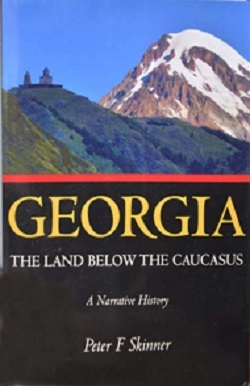
Georgia
The Land Below the Caucasus—A Narrative History
“War is God’s way of teaching Americans geography,” so Mark Twain is said to have remarked. If so, our own Diogenes on this occasion seemingly overestimated providential prowess. Mention Georgia, and most Americans will blink ignorantly, knowing next to nothing about this fascinating nation that Russian troops invaded in 2008 in support of minority ethnic separatists. Indeed, for upwards of three millennia, Georgia has resisted every attempt at conquest and assimilation by Greeks, Romans, Mongols, Byzantines, Persians, Arabs, Turks, and three successive Russian regimes: Tsarist, Bolshevik, and Putin. In doing so, Georgians preserved their own unique language and culture, as well as their distinct Christian faith, which they embraced 500 years before Russia’s comparable conversion. Little of this has registered on our global consciousness.
So all honor to Peter F. Skinner, a British-born author and seasoned traveler, who offers us one of the few carefully sourced, English-language accounts of Georgian history. His narrative begins in the 4th century BCE, or roughly from the age of Prometheus, who was punished for his impudence on a craggy Caucasian peak, and of Jason, whose Argonauts wrested the Golden Fleece from the Black Sea kingdom of Colchis. Skinner recounts every imperial assault on Georgia, culminating with the Bolshevik conquest following a false dawn in 1918-1921 when Georgia was briefly independent, along with Armenia and Azerbaijan.
Each successive invasion is meticulously recorded, and some accounts have a contemporary resonance.
For example, in the 16th century both the Ottoman and the Persian empires sought to incorporate Georgia and its strategically vital territories at the base of the Caucasus mountains. As Skinner relates, “Both empires attempted to secure the whole of Caucasia. Georgia suffered repeated devastation, with the invaders seizing tens of thousands of men, women and children for military and sexual services. Fortunately, the adherence of Turkey’s sultans to the Sunni creed, and Persia’s shahs to the Shi’ah creed of Islam, brought about wars between the two states. Sultans and shahs alike saw themselves as leaders of the faith in the purest form. Had religious hostility given way to military alliance, Georgia could well have been annihilated.”
Similarly, the echoes are distinct in Skinner’s account of Georgia’s vain effort to sustain its statehood between 1918 and 1921. Then as now, it was hostage to wider military events and to shifting tides of Great Power diplomacy. Initially, both the Western Allies and Russia’s new rulers appeared to support the newborn Georgian Democratic Republic. But Tbilisi’s leaders were Mensheviks, not Bolsheviks, and nobody better grasped the complexities of Georgian politics than Lenin’s Commissar of Nationalities, Joseph Stalin, a failed priest born in Gori. In the early 1920s, when the war-weary West was otherwise engaged, the Kremlin threw its support to the Ossetians, a people with historic Persian roots who were long at odds with the Tbilisi government. Inescapably, as the White threat faded, along with Western promises of aid, the Russians invaded Georgia in 1921. In his final chapter, Skinner tersely recounts Georgia’s brutal decades of repression, enforced by Stalin’s security chief, Lavrenti Beria, born a Mingrelian, another quarrelsome sub tribe.
One is struck by how chance and human agency so often determine a small nation’s destiny. Consider the Russian tsar’s fortuitous choice of Count (later Prince) Mikhail Vorontsov (1782-1856) as his viceroy in the Caucasus, signifying that he reported solely to His Imperial Highness, bypassing the Petersburg bureaucracy. As Skinner writes, Nicholas I’s decision in 1844 to send Vorontsov to govern the Caucasus, then seething with rebellion, “was among the wisest he ever took.” Uniquely, Vorontsov was at once an Anglophile and a patrician liberal by upbringing, a hero of the Napoleonic wars, and a seasoned governor-general of the New Russia. In Tbilisi, he founded schools, revived a depressed economy, modernized ports and highways—and patronized a flowering of Georgia’s literary, musical, and theatrical culture.
Georgia‘s pages are lavishly illustrated in both color and in black and white, drawn from impossible-to-find century-old (or even older) published sources, which the author has somehow excavated. His book, adorned with maps and charts, is published independently by the author, itself a commentary on the shrinking space for books like this that have a specialized audience. Of particular interest is the author’s gallery of verbal and visual depictions of Georgia’s urban culture.
The contradictions within Georgia produced Joseph Stalin, the avenging monster who later turned on his homeland, slaughtered its dissident Communists, and during World War II, expelled entire Caucasian nations (Chechens, Ingush, Karachai, Balkars, plus Crimean Tatars). Yet the same culture also nurtured Eduard Shevardnadze, the just-deceased reformer who helped bury the system that Stalin created. Add to the contradictions the varied faces in the Georgian diaspora, such as George Balanchine (whose brother, the eminent composer Andria Balanchivadze, stayed at home), plus the amazing Mdivani family, which added Georgian flavor to café society in London, Paris, and New York. If you wish to understand how and why this happened, consult Peter Skinner’s book. It fills a niche on the shelf of our world’s expanding national biographies.
Reviewed by
Karl E. Meyer
Disclosure: This article is not an endorsement, but a review. The publisher of this book provided free copies of the book to have their book reviewed by a professional reviewer. No fee was paid by the publisher for this review. Foreword Reviews only recommends books that we love. Foreword Magazine, Inc. is disclosing this in accordance with the Federal Trade Commission’s 16 CFR, Part 255.
